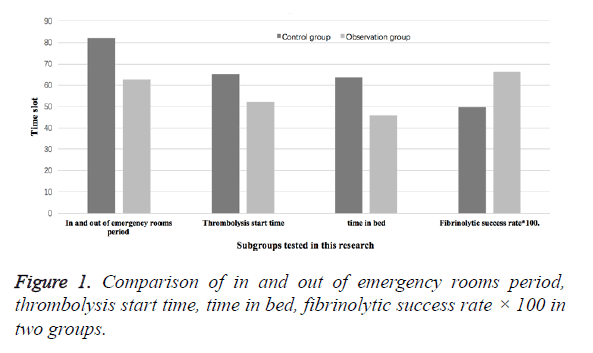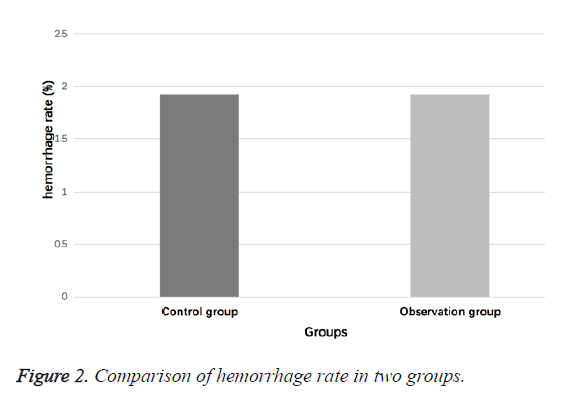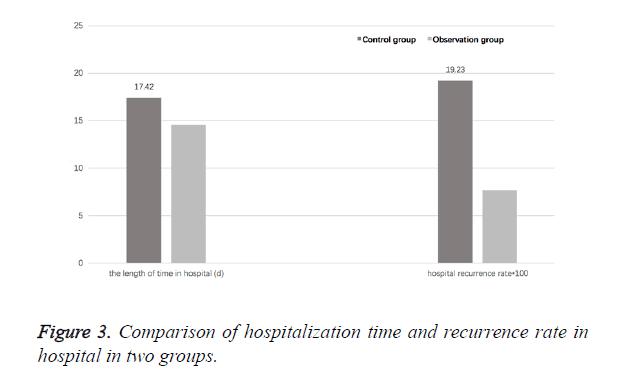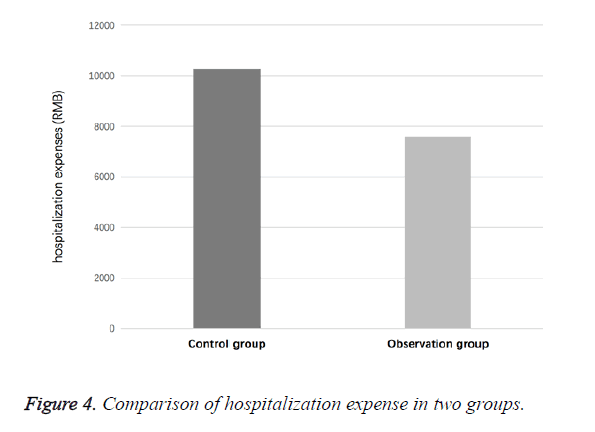ISSN: 0970-938X (Print) | 0976-1683 (Electronic)
Biomedical Research
An International Journal of Medical Sciences
Research Article - Biomedical Research (2017) Volume 28, Issue 11
Therapeutic effect of improved emergency nursing procedure on the thrombolysis of Acute Myocardial Infarction (AMI) patients
Haiying Wu1*, Wenjing Zhang2*, Hongmei Ma1 and Li Li3
1Emergency Department, Tangshan Workers Hospital, 27, Wenhua Road, Lubei District, Tangshan City, Hebei Province, PR China
2Third Critical Care Department, Tangshan Workers Hospital, 34, Longze Nan Road, Tangshan City, Hebei Province, PR China
3Outpatient Department, Tangshan Workers Hospital, 27, Wenhua Road, Lubei District, Tangshan City, Hebei Province, PR China
- *Corresponding Author:
- Haiying Wu
Emergency Department
Tangshan Gongren Hospital, PR China
Wenjing Zhang
Third Critical Care Department
Tangshan Gongren Hospital, PR China
Accepted on March 30, 2017
Objective: This research was to study the influence of the improved emergency treatment procedure on the therapeutic effect of thrombolysis on Acute Myocardial Infarction (AMI) patients.
Methods: 52 AMI thrombolysis patients that our department received and cured through the improved emergency treatment procedure from May to December 2016 are selected into the observation group. 52 AMI thrombolysis patients that our department received and cured through routine nursing from May to December 2016 are selected into the Control Group. A comparison is conducted on the effect of thrombolysis, the length of hospital stays, and the hospitalization expense and recurrence rate in the hospital between the two above-mentioned groups.
Results: In the comparison with the control group, the observation group manifests a relatively shorter length of time in the emergency room, thrombolysis treatment and bed rest. Meanwhile, the success rate of thrombolysis is higher than the control group, and there is significant difference between the two groups (p<0.05). No significant difference is manifested in the comparison between the two groups in the hemorrhage rate (p>0.05). There is a significant difference between the two groups, the observation group manifests a shorter length of hospital stays, lower hospitalization expense and AMI recurrence rate in the hospital than the control group (p<0.05).
Conclusion: The improvement of the emergency nursing procedure can enhance the efficiency of thrombolysis, shorten the length of hospital stays, reduce the recurrence rate and ultimately, reinforce the quality of nursing for AMI patients.
Keywords
Emergency nursing, Acute myocardial infarction, Thrombolytic therapy, Quality of nursing
Introduction
Acute Myocardial Infarction (AMI) is a critical and serious illness that’s commonly seen in the emergency department [1]. AMI, whose clinical features include acute chest pain and dynamic changes in electrocardiogram and myocardial enzyme is mostly found among the seniors and results in a relatively high mortality rate [2,3]. Intravenous thrombolysis in emergency treatment can facilitate the recanalization of coronary artery, prevent remodeling of the left ventricle [4], through which, patients’ cardiac functions and prognosis can be improved, and the short-term and long-term mortality rate can be reduced. Since thrombolytic theory manifests better effect when it is conducted earlier in the emergency department, enhancing the efficiency of thrombolytic treatment in the emergency department and fighting for the precious time for the patients is an important guarantee of raising the success rate of treatment and improving the patients’ prognosis. A scientific and reasonable treatment procedure plays an important role. As a method of improving the vulnerable spots and hidden dangers at work [5], the improvement of the treatment procedure aims at better serving the patients and reinforcing the patients’ experience of seeking medical advice [6].
Information and Methods
General information
42 AMI thrombolysis patients that our department received and cured from January to June 2016 are selected into the observation group in accordance with the following standards [7,8]: (1) patients can meet the standard of acute myocardial infarction diagnosis by WHO, and receive a definite diagnosis of acute myocardial infarction. (2) the duration of continuous chest pain ≥ 30 min, and such chest pain cannot be alleviated through nitrates; (3) patients adopt thrombolytic therapy, agree with the therapeutic schedule and are willing to participate in the research; (4) patients have a clear mind and normal thinking, and can read or answer questions; (5) patients didn’t and don’t suffer from any severe mental diseases. Exclusion standards include: (1) patients die within 24 h after being hospitalized; (2) patients also suffer from acute cerebrovascular disease; (3) patients also suffer from lesion of several major organs, such as lung, liver and kidney; (4) patients with cardiomyopathy and cardiac valve; (5) patients also suffer from malignant tumor; (6) patients also suffer from infection and blood disorders; (7) patients with thinking and mental disorder. Specifically speaking, there are 23 men and 19 women at the age of 45 to 75 years old, and the average age is 48.5 ± 8.5 years old. It takes 4 to 8 hours from the attack of the disease to the patient’s’ hospitalization, and the average duration is 4.4 ± 1.5 h. Cardiac functional grading: there are 20 Level-II cases and 22 Level-III cases. 40 AMI thrombolysis patients that were received and cured from June to December 2015 are selected into the control group, in which there are 22 men and 18 women at the age of 45 to 75 years old, and the average age is 48.5 ± 8.5 years old. It takes 2 to 7 h from the attack of the disease to the patient’s’ hospitalization, and the average duration is 4.2 ± 1.3 h. Cardiac functional grading: there are 19 Level-II cases and 21 Level-III cases. In terms of general information, there’s no significant difference between the two groups (P>0.05), which is comparable.
Methods
After the two groups of patient are hospitalized, they rest in bed and adopt urokinase intravenous thrombolysis based on oxygen inhalation, electrocardiograph monitoring and sedation therapy. The routine emergency treatment procedure is adopted in the control group, in which, rescue and nursing work are conducted per the doctor’s advice. The improved emergency treatment procedure is adopted in the observation group, in which, the original working pattern and shift arrangement are improved, and CPN emergency treatment path is formulated.
Improvement of working pattern
In accordance with Description of Nursing, MICU nurses are divided into four grades [9], namely, responsible group leader (N3), responsible senior nurse (N2), responsible junior nurse (NI) and assistant nurse (J0). The administrative system of head nurse-responsible group leader and the technical management system of responsible group leader-responsible senior nurse-responsible junior nurse-assistant nurse are established. The nurses adopt the system of overall responsibility rationing on the patients, and provide the patients with one-on-one full service from during their hospitalization.
Improvement of shift arrangement
Continuous shift arrangement of nursing is implemented in groups as a unit [10]. The previous eight shifts are re-organized into five shifts, and the office and flexible shifts are retained. In addition, continuous arrangement of early, afternoon and night shifts are implemented. The early shift is from 7:30 to 15:30, the afternoon shift is from 15:00 to 22:30, and the night shift is from 22:00 to 8:00. There is a 30min break during each shift for meals. The exact time of shifting is 8:00, 15:00 and 22:00 respectively.
Emergency treatment CPN [11,12]
The treatment work is conducted by doctors, assisted by the group leader of nursing and responsible nurse. The horizontal axis of the emergency treatment path is the time of hospitalization, projects and requirements of clinical nursing path, variation records (yes or no, causes), signature of nurse. The nursing with AMI thrombolysis is divided by the duration: 1 min of nursing includes having the patient lie on the back, loosening the collar and trouser belt, and starting oxygen inhalation and antiplatelet therapy; 5 min of nursing includes the setting of above two intravenous lines, retaining the blood preparation, conducting electrocardiogram, blood pressure and blood oxygen monitoring, taking chest radiography by the bed, putting nitroglycerine under the patient’s tongue, and determining whether intramuscular injection of 2 mg of morphine or 50-100 mg of pethidine is needed according to the condition; 30 min of nursing includes indispensable thrombolytic therapy. Throughout the whole process, psychological counseling should be conducted on the patients according to their mental state, health education should also be implemented, and the state of illness and complications must be closely observed [13].
Observation indexes
The effect of thrombolytic therapy is evaluated by the time of entering and leaving the emergency room, the commencement of thrombolytic therapy, the bed rest time, the success rate of thrombolysis and hemorrhage [14,15]. Specifically speaking, the success rate of thrombolytic therapy is evaluated by the condition of vascular recanalization: (1) arrhythmia within 2 h of treatment; (2) the degradation of ST segment elevation is >50; (3) serum CK, CK-MB peak emerges before the expected time (14 h); (4) chest pain is basically alleviated within 2 h. Patients who can meet the above two or two more conditions are determined diagnosis for vascular recanalization, which means the thrombolytic therapy is successful.
Hospitalization time and expense, and recurrence rate in hospital
Statistical method: SPSS20.0 software is adopted in the statistical analysis. The data of measurement is represented by ͞x ± S, and tested by t. The data of enumeration is represented by rate, and tested by χ2. The difference p<0.5 is of certain statistical significance.
Results (Figures 1-4)
SPSS20.0 software is adopted in the statistical analysis. The data of measurement is represented by ͞x ± S, and tested by t. The data of enumeration is represented by rate, and tested by χ2. The difference p<0.05 is of certain statistical significance.
Discussion
AMI is a result of atherosclerosis of coronary artery, which leads to thrombosis, which blocks the lumen of coronary artery and triggers myocardial ischemia [16,17]. It manifests certain features, such as acuteness in attack, rapid progress of illness and high mortality rate. There are nearly 3 million new AMI patients in China every year. Besides, with the increase of patients with coronary heart disease in recent years, the morbidity has been rising. The death of AMI patients can be mainly attributed to organ failure or arrhythmia and cardiac rupture thus incurred. Thrombolytic therapy is the easiest and most effective treatment for AMI. It realizes recanalization of the blocked coronary artery through thrombolysis, and reperfusion of the ischemic myocardium [18,19]. Thus, blood vessels are promptly rebuilt which can rescue the failing myocardium and improve patients’ cardiac function. It is reported that myocardial cell under the endocardium manifests necrosis within 18 min of coronary artery occlusion [20,21], and within 3 h, the area of necrosis reaches two thirds, and transmural myocardial necrosis may be incurred within 6 h. In the early stage of quick thrombolytic therapy, facilitating myocardium reperfusion is the key to saving the patients’ life. However, the ultimate success of AMI treatment through thrombolytic therapy derives from not only the time window, but also the normalized nursing procedure.
It is reported that the improvement of nursing procedure for emergency treatment towards a more normalized, programmed and standardized direction can enhance the level of specialized nursing for emergency treatment. Our department has improved the nursing procedure of thrombolytic therapy for AMI. It is suggested by the result that in comparison with the control group, the observation group manifests a relatively shorter length of time in the emergency room, thrombolysis treatment and bed rest; and higher success rate of thrombolysis than the control group, and there is significant difference between the two groups (p<0.05). On one hand, the implementation of overall responsibility rationing under hierarchical management motivates different layers of nurses at work and reinforces their sense of responsibility. On the other hand, the continuous shift arrangement reduces the number of shifts, which made it convenient for nurses to comprehensively grasp the patients’ state of illness and eliminate hidden dangers in nursing. Thanks to the formulation of CPN for emergency treatment, the rescue and nursing of AMI patients has become more predictable, planned and scientific. The next step of rescue and treatment measure can be predicted by time. In this way, instead of blindly executing the doctor’s advice, nurses will take the initiative to participate in the nursing, which avoids the waste of time caused by various factors, creates conditions for the prompt recanalization of relevant infarcted artery and the rescue of more myocardium, and shortens the time that patients spend in the various links.
The result of this research also suggests that the improved emergency treatment procedure in the observation group enhances the recurrence rate of AMI, and reduces the hospitalization time and expense for the patients, which manifests a significant difference from the control group (p<0.05). After the improvement of the nursing procedure, nurses can provide proactive and well-organized service in accordance with a unified schedule, which effectively reduces the recurrence rate of AMI and the occurrence of other adverse events, and lays a foundation for patients’ rehabilitation. In conclusion, the improvement of emergency treatment procedure can enhance the efficiency of thrombolytic therapy for AMI, shortens the hospitalization time and reduces the recurrence rate.
References
- Kennedy RL, Harrison RF, Burton AM. An artificial neural network system for diagnosis of Acute Myocardial Infarction (AMI) in the accident and emergency department: evaluation and comparison with serum myoglobin measurements. J Comp Meth Prog Biomed 1997; 52: 93-103.
- Bu P, Li C, He H. The clinical significance of analysis and dynamic change in high frequency electrocardiogram of acute myocardial infarction. Shandong J Biomed Eng 1996.
- Goodacre S, Locker T, Morris F. How useful are clinical features in the diagnosis of acute, undifferentiated chest pain. J Acad Emerg Med Off Soc 2002; 9: 203-208.
- Liu B, Duan CY, Luo CF, Ou CW, Wu ZY. Impact of timing following acute myocardial infarction on efficacy and safety of bone marrow stem cells therapy: a network meta-analysis. Stem Cells Int 2016; 2016: 1031794.
- Gheorghe AV, Dan VV. Quantitative vulnerability assessment and management of critical infrastructures: indicators and structural changes. Res Gate 2003.
- Elzawawy AM, Elbahaie AM, Dawood SM. Delay in seeking medical advice and late presentation of female breast cancer patients in most of the world. Could we make changes? The experience of 23 years in Port Said, Egypt. J Breast Care 2008; 3: 37.
- Mair J, Smidt J, Lechleitner P, Dienstl F, Puschendorf B. A decision tree for the early diagnosis of acute myocardial infarction in nontraumatic chest pain patients at hospital admission. Chest 1995; 108: 1502-1509.
- Anzellini F. Thrombust; implantable delivery system sensible to self-diagnosis of acute myocardial infarction for thrombolysis in the first minutes of chest pain US. US Patent 20030176797 2003.
- Simon NM, Whiteley S. Psychiatric consultation with MICU nurses: the consultation conference as a working group. Heart Lung 1977; 6: 497-504.
- Wang H, Lun L, Zhou K. Application of continuous shift arrangement and responsibility-bound grouping in nursing management. J Nurs Sci 2009.
- Tang C, Zhang F, Emergency DO. Emergency treatment and nursing countermeasures in 96 patients with organophosphorus poisoning. China Health Stand Manag 2016.
- Zhong W, Wang XW. Clinical study of emergency treatment and selective closed reduction for the treatment of supracondylar humerus fracture in children. J Acute Dis 2016; 5: 466-469.
- Litts DA, Davis M. Suicide prevention efforts for individuals with serious mental illness: roles for the state mental health authority. Suicide Prevention Resource Centre 2008.
- Mathey DG, Sheehan FH, Schofer J. Time from onset of symptoms to thrombolytic therapy: A major determinant of myocardial salvage in patients with acute transmural infarction. J Am Coll Cardiol 1985; 6: 518-525.
- Senior J, Patel N. Reducing thrombolytic therapy time delays in the emergency department. J Qual Clin Pract 1998; 18: 99-107.
- Shiomi M, Ishida T, Kobayashi T. Vasospasm of atherosclerotic coronary arteries precipitates acute ischemic myocardial damage in myocardial infarction-prone strain of the Watanabe heritable hyperlipidemic rabbits. Arterioscl Thromb Vasc Biol 2013; 33: 2518.
- Okayama S, Uemura S, Nishida T. Progression of non-culprit coronary artery atherosclerosis after acute myocardial infarction in comparison with stable angina pectoris. J Atheroscler Thromb 2008; 15: 228-234.
- Li J, Xie M, Mo D. Picroside II protects myocardium from ischemia/reperfusion-induced injury through inhibition of the inflammatory response. Exp Ther Med 2016; 12: 3507-3514.
- Mykhaylichenko VY, Kubyshkin AV, Samarin SA. Experimental induction of reparative morphogenesis and adaptive reserves in the ischemic myocardium using multipotent mesenchymal bone marrow-derived stem cells. Pathophysiol 2016; 23: 95-104.
- Braunwald E, Kloner RA. Retraction of: early recovery of regional performance in salvaged ischemic myocardium following coronary artery occlusion in the dog. J Clin Investig 1981; 68: 225-239.
- Ingwall JS, Kloner RA, Braunwald E. Prolonged derangements of canine myocardial purine metabolism after a brief coronary artery occlusion not associated with anatomic evidence of necrosis. Proc Nat Acad Sci 1980; 77: 5471.



